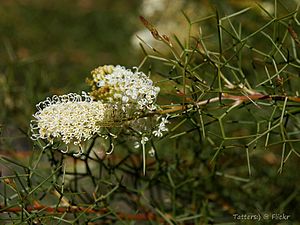Grevillea leucoclada facts for kids
Quick facts for kids Grevillea leucoclada |
|
|---|---|
 |
|
| Conservation status | |
| Scientific classification | |
| Genus: |
Grevillea
|
| Species: |
leucoclada
|
Grevillea leucoclada is a shrub of the genus Grevillea native to a small area on the west coast in the Mid West region of Western Australia.
The spreading intricate shrub typically grows to a height of 1 to 2 metres (3.3 to 6.6 ft) and has glaucous branchlets. It has dissected, tripartite leaves that are deeply divided to midvein. The leaves have a blade that is 60 to 140 millimetres (2.4 to 5.5 in) long. It blooms between August and December and produces an axillary or terminal raceme irregular inflorescence with white flowers with white styles. Later it forms rugose, oblong or ellipsoidal, glabrous fruit that are 10 to 14 mm (0.4 to 0.6 in) long. The plant regenerates from seed only. It is similar to Grevillea intricata, which has the distinguishing features of having non-glaucous branchlets and an erect pollen-presenter.
Grevillea leucoclada is found among medium to low trees in scrubland areas in the lower reaches of the Murchison River and the Geraldton sandplains. It grows in rocky, stony, gravelly or sandy soils in open shrub associations.
The species was first described in by the botanist Donald McGillivray in 1986 in the journal New Names Grevillea.
The specific epithet, leucoclada, derives from two Greek words: leucos (white) and clados (shoot/sprout) which were combined to give leucocladus, - a, -um, describing the plant as having white shoots.


